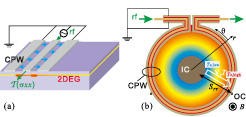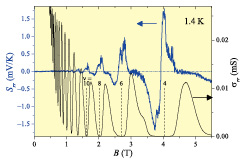Corbino Thermopower of Quantum Hall Systems
Iye Group
Thermopower is known to be a sensitive probe to investigate properties of electron systems, owing to its direct access to the energy derivative of the density of states (DOS) and to the entropy of the systems. It has been predicted [1, 2] that the radial thermopower Srr measured in the Corbino geometry (Fig. 1b) exhibits behaviors qualitatively different from the longitudinal thermopower Sxx measured in the Hall-bar geometry in the quantum Hall (QH) systems. Notably, in the QH plateau regions where the longitudinal conductivity σxx=σrr vanishes, Sxx also vanishes, whereas Srr is expected to take large values changing sign at the center of the QH plateau. The measurement of Srr thus provides us with a unique opportunity to probe the entropy of the system in the QH plateau regions [2]. The measurement of thermopower in the QH systems, however, has predominantly been performed on the Hall-bar geometry. In the present study, we make measurements of the diffusion thermopower Srr in the Corbino geometry [3].

Fig. 1. Schematic diagrams of (a) coplanar wave guide (CPW) used in the microwave-heating technique and (b) Corbino device to measure diffusion thermopower Srr. IC: inner contact. OC: outer contact. The microwaves (rf) propagating through the CPW placed on the surface are partially absorbed by the two-dimensional electron gas (2DEG) underlying the slot of the CPW and heats the electrons. In the Corbino device, electrons near the outer periphery of the disk are heated by the CPW, generating the concentric temperature gradient toward IC.

Fig. 2. Thermopower Srr (left axis) and the conductivity σrr (right axis) measured in the Corbino device. Vertical dashed lines indicate the positions of the center of the QH plateau (exact even integer fillings ν).
Thermopower generally contains contributions from two distinct mechanisms: diffusion and phonon drag. In the QH systems embedded in GaAs/AlGaAs wafers, it is well known that the latter contribution outweighs the former by orders of magnitude, if the temperature gradient is introduced by an external heater. The high sensitivity to the DOS and entropy, however, is expected only for the former. In order to measure the diffusion contribution selectively, we employ microwave-heating technique [4] (Fig. 1a) in the present study; microwaves injected into the coplanar wave guide (CPW) placed on the surface of the wafer capacitively couple with the two-dimensional electron gas (2DEG) beneath the slots of the CPW and locally heats the electrons. The lattice temperature remains intact, eliminating the phonon-drag contribution. As depicted in Fig. 1b, we install CPW along the outer periphery of a Corbino disk, which introduces radial temperature gradient toward the center electrode, leading to the radial thermopower Srr.
The measured Srr is plotted in Fig. 2 along with σrr obtained in the same Corbino device. As can be seen in the figure, Srr takes large values (~ ±1 meV/K) in the regions where σrr = 0, alternating the sign at exact even integer fillings marked by vertical dashed lines, in accordance with the theoretical prediction mentioned above. Noting that Srr represents entropy per carrier [2], large values of | Srr | can be understood as reflecting the fact that only small numbers of thermally activated carriers are available in the QH plateau regions. The positive (negative) sign of Srr indicates that the carriers are hole-like (electron-like) for the fillings ν just below (above) integer values.
References
- [1] H. van Zalinge, R. W. van der Heijden, and J. H. Wolter, Phys. Rev. B 67, 165311 (2003).
- [2] Y. Barlas and K. Yang, Phys. Rev. B 85, 195107 (2012).
- [3] S. Kobayakawa, A. Endo, and Y. Iye, J. Phys. Soc. Jpn. 82, 053702 (2013).
- [4] A. Endo, T. Kajioka, and Y. Iye, J. Phys. Soc. Jpn. 82, 054710 (2013).
